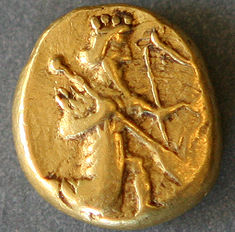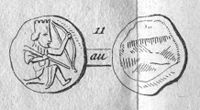
Achaemenid currency
Encyclopedia

Achaemenid Empire
The Achaemenid Empire , sometimes known as First Persian Empire and/or Persian Empire, was founded in the 6th century BCE by Cyrus the Great who overthrew the Median confederation...
was a continuation of the coin
Coin
A coin is a piece of hard material that is standardized in weight, is produced in large quantities in order to facilitate trade, and primarily can be used as a legal tender token for commerce in the designated country, region, or territory....
s of Lydia
Lydia
Lydia was an Iron Age kingdom of western Asia Minor located generally east of ancient Ionia in the modern Turkish provinces of Manisa and inland İzmir. Its population spoke an Anatolian language known as Lydian....
. Coins were issued from 520 BCE-450 BCE to 330 BCE for the Daric
Persian daric
The daric was a gold coin used within the Persian Empire. It was of very high gold quality, with a purity of 95.83%. Weighing around 8.4 grams, it bore the image of the Persian king or a great warrior armed with a bow and arrow, but who is depicted is not known for sure...
and Siglos. It seems that before then, a continuation of Lydian coinage under Persian rule was highly likely . Achaemenid coinage includes the official imperial issues (Darics and Sigloi), as well as coins issued by the Achaemenid governors (Satraps), such as those stationed in ancient Asia Minor
Asia Minor
Asia Minor is a geographical location at the westernmost protrusion of Asia, also called Anatolia, and corresponds to the western two thirds of the Asian part of Turkey...
.
Daric


Currency
In economics, currency refers to a generally accepted medium of exchange. These are usually the coins and banknotes of a particular government, which comprise the physical aspects of a nation's money supply...
system at about 520-480, the precise period is debatable. The rate of exchange was 1 Daric = 20 Siglos. It consisted of a Daric of between 8.10-8.50 grams in weight and based on the Babylonian shekel
Shekel
Shekel , is any of several ancient units of weight or of currency. The first usage is from Mesopotamia around 3000 BC. Initially, it may have referred to a weight of barley...
of 8.33 grams. The purity was between 98-99% gold
Gold
Gold is a chemical element with the symbol Au and an atomic number of 79. Gold is a dense, soft, shiny, malleable and ductile metal. Pure gold has a bright yellow color and luster traditionally considered attractive, which it maintains without oxidizing in air or water. Chemically, gold is a...
.
After the capture of Babylon
Babylon
Babylon was an Akkadian city-state of ancient Mesopotamia, the remains of which are found in present-day Al Hillah, Babil Province, Iraq, about 85 kilometers south of Baghdad...
by Alexander, the Satrap
Satrap
Satrap was the name given to the governors of the provinces of the ancient Median and Achaemenid Empires and in several of their successors, such as the Sassanid Empire and the Hellenistic empires....
Mazaios issued the double Daric of 16.65 grams in weight whose image was based on the Daric coin and bore his name until his death in 328 BCE.
1 Daric = 25 Attic
Attica
Attica is a historical region of Greece, containing Athens, the current capital of Greece. The historical region is centered on the Attic peninsula, which projects into the Aegean Sea...
Drachmae.
Siglos
Siglos is 5.40-5.60 grams each, but is based on the 0.5 Lydian Siglos of 10.73-10.92 grams for the full unit. Purity was at first issue 97-98% but by the middle 4th century was 94-95%.1 Siglos = 7.5 Attic Obol
Obol
Obol may refer to:* Obolus, a type of silver coin used in Ancient Greece* Obol , a programming language* Obol Investment, a Swedish company involved in a major fraud scandal...
s
Archaeological finds
Daric coins have been found in Asia MinorAsia Minor
Asia Minor is a geographical location at the westernmost protrusion of Asia, also called Anatolia, and corresponds to the western two thirds of the Asian part of Turkey...
, Greece
Ancient Greece
Ancient Greece is a civilization belonging to a period of Greek history that lasted from the Archaic period of the 8th to 6th centuries BC to the end of antiquity. Immediately following this period was the beginning of the Early Middle Ages and the Byzantine era. Included in Ancient Greece is the...
, Macedonia
Macedonia (region)
Macedonia is a geographical and historical region of the Balkan peninsula in southeastern Europe. Its boundaries have changed considerably over time, but nowadays the region is considered to include parts of five Balkan countries: Greece, the Republic of Macedonia, Bulgaria, Albania, Serbia, as...
and Italy
Italy
Italy , officially the Italian Republic languages]] under the European Charter for Regional or Minority Languages. In each of these, Italy's official name is as follows:;;;;;;;;), is a unitary parliamentary republic in South-Central Europe. To the north it borders France, Switzerland, Austria and...
. The Siglos denomination have been found in hoards only in Asia Minor, and single coins with other Greek coinage from Ancient Egypt
Ancient Egypt
Ancient Egypt was an ancient civilization of Northeastern Africa, concentrated along the lower reaches of the Nile River in what is now the modern country of Egypt. Egyptian civilization coalesced around 3150 BC with the political unification of Upper and Lower Egypt under the first pharaoh...
to Afghanistan
Afghanistan
Afghanistan , officially the Islamic Republic of Afghanistan, is a landlocked country located in the centre of Asia, forming South Asia, Central Asia and the Middle East. With a population of about 29 million, it has an area of , making it the 42nd most populous and 41st largest nation in the world...
and Pakistan
Pakistan
Pakistan , officially the Islamic Republic of Pakistan is a sovereign state in South Asia. It has a coastline along the Arabian Sea and the Gulf of Oman in the south and is bordered by Afghanistan and Iran in the west, India in the east and China in the far northeast. In the north, Tajikistan...
, making it an important issue for the region.

